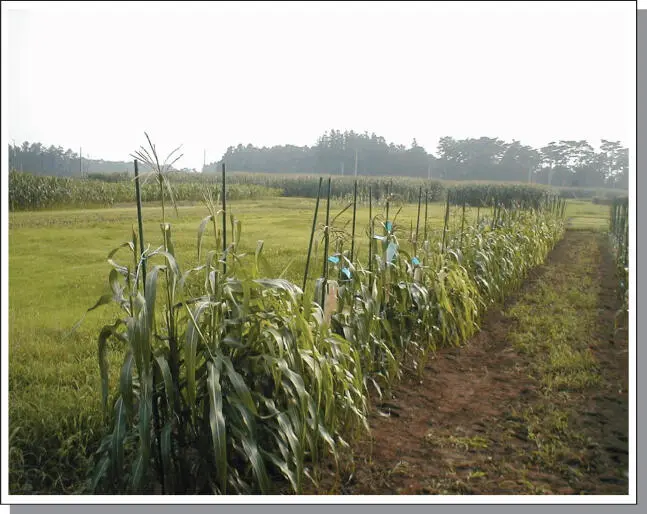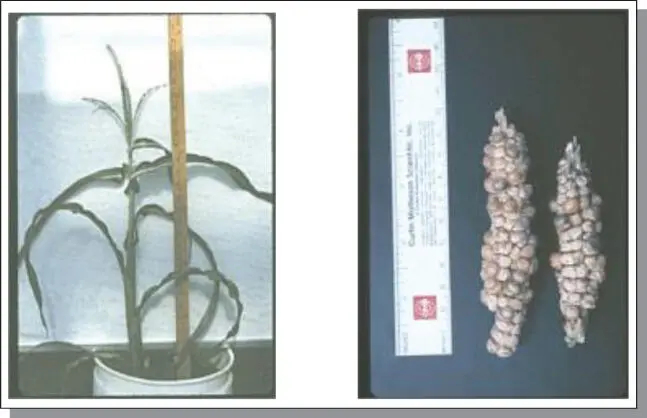Evaluation of both apomictic 38‐chromosome and 39‐chromosome individuals that have been increased over several locations for a minimum of 15 years ( Figure B6.6), has shown that a low level of genome reorganization does occur, sometimes resulting in genome loss. This behavior is well documented in some of the apomictic Petrov materials and can only be visualized following the passage of time. The generation of a Mz6L‐Tr16L translocation is quite likely a product of this type of behavior (Kindiger and Dewald 1996; Kindiger et al. 1996b). In addition, a long‐term (15+ years) selection program in a 38‐chromosome (20Mz + 18Tr) apomictic genotype has resulted in a pollen sterile, apomictic line that has a near‐perfect resemblance to maize in its plant and ear characteristics ( Figure B6.7a,b). Consequently, the occurrence of FDR events in apomictic maize‐ Tripsacum hybrid should generate some concern regarding the development of apomictic off‐types which, over time, would increase the genetic non‐uniformity of a particular genotype.

Figure B6.6A series of 39‐chromosome maize‐ Tripsacum (30Mz + 9Tr) hybrids growing at the Japanese National Livestock and Grassland Research Institute, Nishinasuno, Japan.

Figure B6.7(a) (left). A highly maize‐like 38‐chromosome apomictic maize‐ Tripsacum hybrid. This selection has none or few tillers and exhibits a distinct maize phenotype. (b) (right). A top and second ear taken from one of these highly maize‐like apomictic individuals. Note the eight rows on the ear is rarely found in other apomictic maize‐ Tripsacum hybrids.
Potential advantages of apomictic hybrid corn
Utilizing a traditional hybrid corn production methodology, two inbred lines are typically required to produce an F 1hybrid. At the present time, apomictic hybrids would likely utilize one or both inbred lines that would carry the necessary genes and genetics to develop a true breeding, apomictic F 1hybrid corn cultivar. Land, labor, and storage space are also required to maintain these inbred lines. If true breeding, apomictic hybrids can be developed, the yearly seed increase of inbreds, the generation of hybrids, the necessary time allowed for such production, land, fertilizer, and required field isolations necessary for producing a hybrid corn line could be omitted. With apomictic hybrid corn, seed generated from that crop would reproduce seed and individuals possessing the identical genetics of the parental hybrid. As such, the development of an apomictic seed crop from an apomictic hybrid would lead to a substantial savings in cost and time to commercial producers and hopefully a decrease in seed price to farmers.
Under present agricultural patents and plant variety protection legislation, farmers are able to retain a limited amount of their produced seed for their own use. This could be particularly advantageous to poorer farmers in developing countries. In addition, farmers who live in remote regions where government or commercial seed suppliers are not available could essentially guarantee themselves a yearly supply of quality hybrid seed. These farmers would not be dependent on government or commercial seed suppliers once a suitable cultivar was introduced into their area and could provide farmers greater control regarding the production and use of their locally generated product. However, farmers utilizing such “on the farm seed production rational” need to be aware of seed quality issues as well as the enforceable and legal ramifications of selling and or distributing such seed protected by licence, patent, or PVP. Growers should also be aware that the lack of genetic diversity or uniformity that is embedded in their apomictic seed crop could eventually make that variety susceptible to a particular disease infestation. Retaining and sowing an apomictic seed crop over the long term could eventually result in major disease infestations and a dramatic reduction in crop yield.
At this time, it is difficult to visualize how the application of cytogenetics, molecular genetics, mapping, and genetic engineering, coupled with traditional breeding procedures, will be readily integrated to incorporate apomixis into maize and develop a apomictic hybrid corn cultivar anytime in the near future. Some have given the development of apomictic hybrid corn an approximate twenty‐year horizon; others much longer. As has been discussed above, the research process to be utilized to develop apomictic corn, or other species is time consuming, difficult and generates several legal, social, breeding and genetic issues that will need to be resolved. Though the transfer of apomixis holds much promise, it will be some time before a commercial apomictic maize hybrid will reach the marketplace.
1 Albertini, E., Barcaccia, G., Porceddu, A. et al. (2001). Mode of reproduction is detected by Parth1 and Sex1 SCAR markers in a wide range of facultative apomictic Kentucky bluegrass varieties. Molecular Breeding 7: 293–300.
2 Bantin, J., Matzk, F., and Dresselhaus, T. (2001). Tripsacum dactyloides (Poaceae): a natural model system to study parthenogenesis. Sexual Plant Reproduction 14: 219–226.
3 Bashaw, E.C. and Hignight, K.W. (1990). Gene transfer in apomictic buffelgrass through fertilization of an unreduced egg. Crop Science 30: 571–575.
4 Blakey, C. A., E. H. Coe Jr., and C. L. Dewald. 1994. Current status of the Tripsacum dactyloides (Eastern gamagrass) RFLP molecular genetic map. Maize Genetics Coop. Newsletter No. 68. University of Missouri, Columbia, MO. pp. 35–37.
5 Blakey, C.A., Goldman, S.L., and Dewald, C.L. (2001). Apomixis in Tripsacum: comparative mapping of a multigene phenomenon. Genome 44: 222–230.
6 Borovsky, M. (1966). Apomixis in intergeneric maize‐Tripsacum hybrids. In: Meeting on Problems on Apomixis in Plants, 8–9. Saratov, Russia: Saratov State University.
7 Borovsky, M. and Kovarsky, A.E. (1967). Intergenus maize‐Tripsacum hybridizations. Izvestia Akademii Nauk Moldovaski, SSR 11: 25–35.
8 Burson, B.L., Voigt, P.W., Sherman, R.A., and Dewald, C.L. (1990). Apomixis and sexuality in eastern gamagrass. Crop Science 30: 86–89.
9 Carmen, J.G. (1997). Asynchronous expression of duplicate genes in angiosperms may cause apomixis, bispory, tetraspory and polyembryony. Biological Journal of the Linnean Society 61: 51–94.
10 Grimanelli, D., Leblanc, O., Espinosa, E. et al. (1998). Mapping diplosporous apomixis in tetraploid Tripsacum: one gene or several genes? Heredity 80: 33–39.
11 Harlan, J.R. and de Wet, J.M.J. (1977). Pathways of genetic transfer from Tripsacum to Zea mays. Proceedings of the National Academy of Sciences of the United States of America 74: 3494–3497.
12 Kindiger, B. (1993). Aberrant microspore development in hybrids of maize x Tripsacum dactyloides. Genome 36: 987–997.
13 Kindiger, B. and Beckett, J.B. (1989). Cytological evidence supporting a procedure for directing and enhancing pairing between maize and Tripsacum. Genome 33: 495–500.
14 Kindiger, B. and Beckett, J.B. (1992). Popcorn germplasm as a parental source for maize x Tripsacum dactyloides hybridization. Maydica 37: 245–249.
15 Kindiger, B. and Dewald, C.L. (1996). A system for genetic change in apomictic eastern gamagrass. Crop Science 36: 250–255.
16 Kindiger, B. and Dewald, C.L. (1997). The reproductive versatility of eastern gamagrass. Crop Science 37: 1351–1360.
Читать дальше














